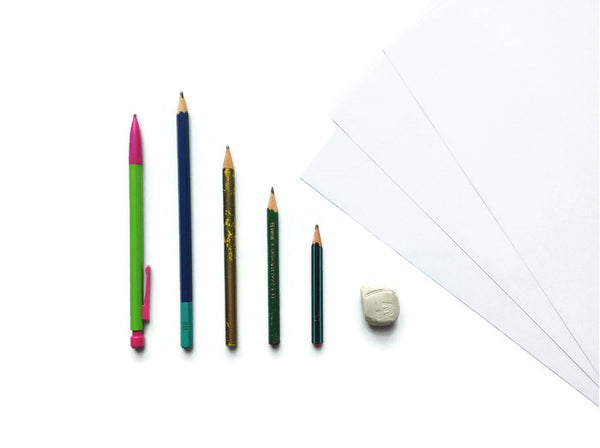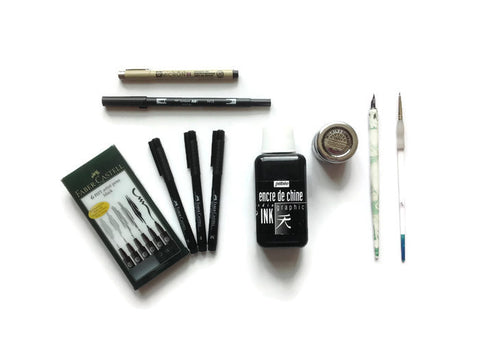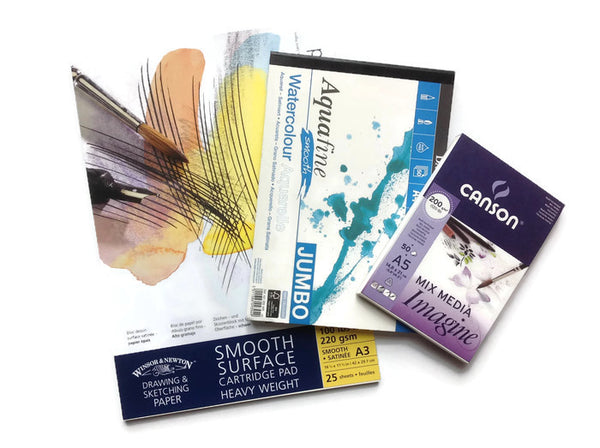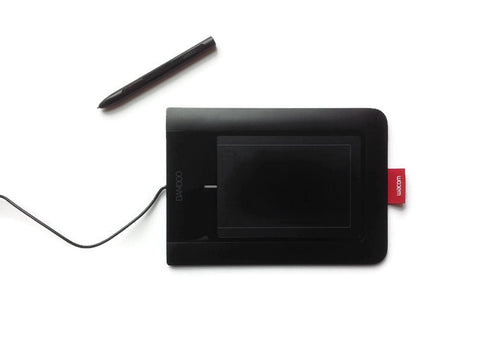My Favourite Art Materials And Tools

(Edited 20/03/2020)
Hi everyone!
I often get asked what art materials and tools I use so I thought that I would write a blog post to cover this topic.
Since I use different types of materials at different stages of my work process I decided to split up this post following said process so you can see what I use and when.
Before we dive in: this post uses affiliate links. It means that if you buy something through them I will get a small commission. You won’t pay a penny more, but it helps me out (thank you!).
Also, the art materials and tools that I talk about are my favourites at this point in time. It took a lot of trying various things to come up with this list. They are what works for me and by no means recommendations as to what I think you should use, so feel free to try some of them too if you want, but what matters is that you find the tools and materials that work for you. ;)
Let’s go!
1) Sketching

At the sketching stage I am not too fussed about the quality of my tools so I use very simple and cheap materials that everybody has at home.
Pencils
My favourite sketching pencils are a simple HB pencil that one of my illustrator friends gave me as a Christmas present about three years ago, a 2H pencil that I use when I want my lines to be very pale and ‘dry’, and an old BIC MatiC 0.7mm mechanical pencil for smaller details. For thicker or darker lines I use an old B pencil that I found in my parents’ stuff ages ago (it has ‘Europa 1992’ written on it so might or might not have been made in celebration of the Maastricht treaties which made the EU official, or of the UEFA Europa League of 1992; but anyways, that shows how old it is) and a 2B pencil that, if I remember correctly, was part of my new school materials for my Arts class back when I was 13 years old (I am over 30 now).
Paper
I tend to use sketchbooks for drawing for fun and developing personal ideas but when I work on illustrations for a client, or illustrations that I know I will trace on my light table or scan, then I sketch on sheets of printer paper instead: they are inexpensive and easier to pop into my scanner than a whole sketchbook!
2) Outlining

This is where I care a bit more about the quality of the material that I use for one simple reason: better material tends to last longer so it is a better investment in the long run. At this stage I choose different tools and materials depending on what the next stages of the work process are going to be and on what the finished piece is going to look like.
Nib pen
I’m not sure what make my dip pen is but I thought it was pretty when I bought it and it makes me happy to draw with such a pretty tool. These days I use a Joseph Gillott 404 nib with it.
Brush
My go-to brush for India ink outlines is a Royal Soft-grip SG250 (size 0) by Royal & Langnickel.
India ink
Over time I have tried a few different brands but at the moment I am using black Pébéo Graphic India ink and I absolutely love it! It dries pretty quickly and it is a pleasure to ink with as it is not too thick and flows very well on paper compared to some other brands I have tried before.
Artist pens
(Edited)
-
Black Faber-Castell artist pens. I got a set and use them all apart from the calligraphy pen. It is a nice range for clean black lines.
-
Equally good, the black Sakura Pigma Micron (size 04) which is great for small details.
-
One of my recent purchases is a black Tombow dual brush pen and I love it! I use it to create ‘irregular’ strokes when I am on the move or when I don’t have time to get my brush and India ink out!
-
If you’re looking for black irregular strokes that you can paint over with ink or watercolour, the Fudenosuke brush pen (GCD-112 soft tip), still by Tombow, is A W E S O M E! No bleeding/smudging accidents to report with that one at this stage.
-
The Tombow Fudenosuke brush pen (GCD-111 hard tip) is a good companion for more regular strokes or smaller details.
3) Colouring

I use various colouring techniques and materials depending on my mood and on the type of work. Here is what I use the most:
Brushes
I have a LOT of different brushes! Some I bought myself, some I had back when I was at school, others I received as gifts.When it comes to my favourite brushes (as in the ones I use the most for my work) though, you can count them on the fingers of one hand. Literally.
-
For small details I use a Royal Soft-grip SG250 (size 0) by Royal & Langnickel (the same as the brush I use for India ink outlines, just a different brush so I don't accidentally get my colours dirty with black ink);
-
I use a Royal Majestic 4250 size 1 (still by Royal & Langnickel) for most of my brush lettering and when I work with watercolour inks;
-
Also for watercolour and smaller details I use a Cotman brush series 111 in size 2 by Winsor & Newton (this is an amazing brush!);
-
I use a Royal Majestic 4250 size 6 to paint larger surfaces;
-
And finally, for painting out of the studio I use a Pentel Aquash waterbrush. I own three different sizes of these and the ‘medium’ one is the brush I use the most. They are very easy to use and the water reservoir means that you don’t have to worry about taking a jar or some other water recipient with you. These water brushes are also great for travelling: all you have to do is empty/fill the water reservoir when you need to.
Watercolour
The Winsor & Newton Cotman 12 half-pan sketchers’ pocket box is a good basic set. As well as being quite inexpensive, you can create pretty much any colour you can think of just from this small set.
Inks
-
Pébéo Colorex watercolour inks
The colours of these inks are so vibrant and beautiful! I love looking at the colour swatches that I made and taped in front of my desk, and at the colourful bottles of ink (that’s such a geeky thing to say, I know!).
Ink pencils
I got a box of 24 Derwent Inktense ink pencils as a birthday present this year and they are brilliant for adding texture and extra colour to some of my artwork!
White details
To add some white details I use white Posca pens (0.7mm), which are essentially acrylic paint in the form of a pen. They're amazing and I can't get enough of them!
Photoshop
No big surprise here, for digital colouring I simply use Photoshop.
4) Paper

The type of paper that I use depends a lot on what I am going to draw or paint on it, and on how the illustration will be used. For example, the paper needs to be thicker for India ink or watercolour, not too textured if I am going to work with my dip pen, and Bristol paper/card is usually better for illustrations that are going to be scanned because it doesn’t leave texture marks which means that it requires less ‘cleaning’ work on the computer.I have tried (and am still trying) different brands and types of paper but so far the ones I really like are:
-
Great for outlining, brush lettering, scanning: Winsor & Newton Smooth Surface Cartridge Pad (220gsm in A3 to get more drawings on a single page for bigger projects; I can also cut the sheets when I prefer to work on a smaller surface)
-
Great for outlining, dip pen work, watercolour and ink work: Canson Mix Media Imagine (200gsm) and Daler Rowney Aquafine Smooth watercolour paper (Hot Press, 300gsm)
5) ‘Bits of technology’

Although I love working in traditional mediums, technology can’t be overlooked completely as it offers very helpful solutions in order to meet those tight deadlines (you have to move with the times!). Plus technology can save you a lot of time and you can do really cool stuff with it too!
Graphic tablets
(Edited)
Depending on what I’m doing I use either:
-
the small Wacom Bamboo CTL-460 that I got about 9 years ago.
-
or my newly acquired Wacom Cintiq Pro 16.
The Bamboo still works perfectly, it’s nice and small, and it’s my go-to for digital colouring work and for moving things around in a Photoshop document.
In case you’re not familiar with it, the Cintiq range is basically an extra monitor that you connect to your computer and on which you can draw. Because the experience is very similar to drawing on paper, I use my Cintiq mostly for precision work (i.e. work that requires a steady hand) like hand lettering, drawing quick spot illustrations digitally, and anything that requires drawing outlines digitally.
Light table
(Edited)
My Huion LED Light Pad has become one of my favourite tools. Before that I was using my window to trace some of my illustrations. As you can imagine, my light table is way more comfortable to draw on and it means I can work after dark now!
Oh and don’t worry, my light table is still being well used despite the recent arrival of the Cintiq in the family as I still do most of my outlining work traditionally.
Scanner
After quite a bit of research I settled for the Epson Perfection V550 Photo. I remember being like “wooooooow!” when I scanned my first illustration back then. You see, it was so much better than the scan quality of the all-in-one little printer that I had back in the day!
(New) Printer
I print all of my greeting cards and art prints for my Etsy shop myself. It enables me to reduce the amount of stock that I have as well as to test products faster. After doing a thorough research I settled for the Epson Stylus Photo 1500W and I’m very happy with it!
Voilà!
I hope you enjoyed this post and that you found it helpful!

